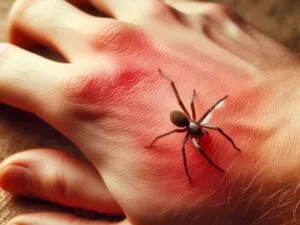What are Tarantula Bites?
Tarantulas, large, hairy spiders belonging to the Theraphosidae family, are often feared, but their bites are rarely life-threatening to humans. These arachnids possess fangs used to inject venom when they bite, primarily as a defense mechanism or to subdue prey. While the bite itself can be painful, resembling a bee sting, the severity of the reaction varies greatly depending on factors such as the species of tarantula, the amount of venom injected, and the individual’s sensitivity. Understanding the nature of tarantula bites is crucial for anyone living in or visiting areas where these spiders are found. Contrary to popular belief, the primary concern isn’t usually paralysis, but rather the local and systemic effects of the venom and the potential for secondary infections. Learning about tarantula bites can help alleviate unnecessary fears and allow for proper precautions and treatment.
Symptoms of a Tarantula Bite
Identifying the symptoms of a tarantula bite is the first step toward proper treatment and minimizing potential complications. The symptoms can range from mild to severe, and it’s essential to recognize the different reactions. The symptoms often involve local reactions at the bite site and may also include systemic reactions affecting the entire body. Recognizing these symptoms is crucial for getting timely medical attention and avoiding further complications. The range of symptoms varies significantly depending on the tarantula species, the amount of venom injected, and the individual’s sensitivity. This information underscores the importance of understanding both local and systemic effects following a tarantula bite.
Local Reactions

Local reactions typically occur at the site of the bite and are the most common type of reaction. These can include immediate pain, often described as a sharp, stinging sensation, followed by redness, swelling, and itching. The pain may subside within a few hours or days, but the swelling and redness might last longer. The bite site may also develop a small, raised bump or blister. In some cases, there might be mild muscle cramps near the bite location. However, in most situations, local reactions are localized and resolve with minimal intervention. Knowing the localized reactions can help you differentiate them from more severe, systemic reactions that might require immediate medical attention. If you experience these symptoms, keep the area clean, apply a cold compress, and take over-the-counter pain relievers.
Systemic Reactions
Systemic reactions are less common but can be more serious, indicating that the venom is affecting the entire body. These reactions may manifest as nausea, vomiting, dizziness, and in rare cases, difficulty breathing or chest pain. Other symptoms could include muscle cramps or spasms, sweating, and a rapid heartbeat. Severe allergic reactions, though rare, could lead to anaphylaxis, a potentially life-threatening condition characterized by swelling of the throat and difficulty breathing. If systemic symptoms appear, seek immediate medical attention. Recognizing these symptoms allows for prompt medical intervention, potentially preventing severe complications and ensuring the best possible outcome. Monitoring for these symptoms can prove invaluable in situations involving tarantula bites, helping to avoid potential serious consequences.
Understanding Paralysis
The fear of paralysis after a tarantula bite is a common concern, but it’s important to clarify the facts. Tarantula venom, while capable of causing pain and discomfort, does not typically contain neurotoxins in amounts that would cause paralysis in humans. Paralysis is a significant loss of muscle function and can result from various causes, including neurological disorders, spinal cord injuries, or exposure to certain toxins. While some spider venoms are known to cause paralysis, this is generally not the case with tarantulas. The symptoms of a tarantula bite mainly involve local reactions (pain, swelling, redness) and, in some cases, systemic reactions (nausea, dizziness, muscle cramps). Understanding the types of venom and the typical effects of a tarantula bite can help reduce unnecessary anxiety. In rare cases, severe allergic reactions might cause symptoms that seem similar to paralysis, such as muscle weakness, but these are not the same as paralysis caused by a neurotoxin.
Can Tarantula Bites Cause Paralysis?

The direct link between tarantula bites and paralysis is extremely rare. Tarantula venom generally does not contain toxins in high enough concentrations to induce paralysis in humans. While some spider venoms, such as those from certain species of recluse spiders, have been known to cause more severe effects, tarantulas primarily use their venom for subduing prey and as a defense mechanism. In most cases, the effects of a tarantula bite are limited to localized pain, swelling, and, sometimes, systemic symptoms like nausea or dizziness. If a tarantula bite causes paralysis, it’s essential to investigate other potential causes, such as an allergic reaction or a pre-existing medical condition. Therefore, it’s important to differentiate between the typical effects of a tarantula bite and the rare possibilities of more severe reactions. Awareness of these facts can help manage both the fear and the reality of tarantula bite incidents.
Factors that Influence Paralysis
Although paralysis from a tarantula bite is exceptionally rare, several factors could theoretically influence the possibility of more severe reactions. These include the species of the tarantula, the individual’s sensitivity, the amount of venom injected, and any pre-existing medical conditions. Some tarantula species may possess more potent venom, though most species pose minimal threat to humans. Individual sensitivity, or allergies, can play a crucial role, as even a minor exposure could cause a severe reaction in highly sensitive individuals. The amount of venom injected also varies, as the spider doesn’t always inject the full amount, which influences the severity of symptoms. Pre-existing medical conditions, such as neurological disorders or autoimmune diseases, might make individuals more susceptible to complications. While these factors don’t directly cause paralysis, they can influence the severity of other symptoms. Understanding these factors can better inform prevention and immediate response strategies.
Tarantula Species
The vast diversity among tarantula species results in varying venom compositions. While all tarantulas possess venom used for hunting and self-defense, the potency and effects differ significantly. Some species, like the African baboon spider, are known for more potent bites, causing more severe pain and discomfort, while other species such as the rose-haired tarantula are considered relatively mild. Knowing the species of tarantula can help in assessing the potential risk of a bite. If you are bitten, it is important to try to identify the species, which can assist medical professionals in providing appropriate treatment. Information about the tarantula can also guide the treatment plan and manage expectations regarding potential symptoms. Understanding the variability among different species is essential in educating people about the real risks associated with tarantula bites.
Individual Sensitivity

Individual sensitivity is a significant factor in how someone reacts to a tarantula bite. Allergic reactions can vary greatly, from mild skin irritation to severe, life-threatening anaphylaxis. Those who have a history of allergies or asthma may be at greater risk of a severe reaction. The intensity of the body’s response also depends on the individual’s immune system and overall health. If an individual is highly sensitive, even a small amount of venom can trigger a disproportionately severe response. Symptoms such as difficulty breathing, swelling of the throat, or rapid heartbeat require immediate medical attention. Knowledge of one’s own sensitivities is therefore important. It is also crucial to be prepared and have necessary medications like an epinephrine auto-injector if you have a history of severe allergies. Understanding and managing individual sensitivities is essential in preparing for and responding to a tarantula bite effectively.
First Aid for Tarantula Bites
Providing the correct first aid for a tarantula bite can reduce the severity of symptoms and prevent complications. The first step is to remain calm and move the person away from the tarantula to a safe area. Clean the bite area gently with mild soap and water to prevent infection. Applying a cold compress to the bite site helps reduce pain and swelling. Keep the affected limb elevated to further minimize swelling. Monitor the person for any signs of systemic reactions, such as difficulty breathing or severe allergic responses. If systemic symptoms are present, seek immediate medical attention. Administering over-the-counter pain relievers, such as ibuprofen or acetaminophen, can help manage pain and discomfort. Accurate and timely first aid can significantly improve the outcome, especially in situations where medical help may be delayed. Knowing these basic first aid steps gives people the knowledge needed to respond to a tarantula bite effectively.
Immediate Actions
The immediate actions after a tarantula bite are critical to mitigating the effects and preventing complications. First, ensure the person is moved to a safe location away from the tarantula to prevent further bites. If the bite occurs on a limb, keep the limb still and elevated to minimize the spread of the venom and reduce swelling. Apply a cold compress or ice pack to the bite area for 10-15 minutes at a time to help alleviate pain and swelling. Gently clean the bite wound with mild soap and water to reduce the risk of infection. Monitor the person closely for any systemic symptoms like difficulty breathing, dizziness, or rapid heart rate. If any of these symptoms occur, seek immediate medical help. The quicker the first aid, the better the potential outcome. Being prepared to act swiftly can make all the difference.
Medical Treatment

Medical treatment for a tarantula bite focuses on managing symptoms and preventing complications. In most cases, treatment is symptomatic, involving pain relief and addressing local reactions. Doctors might prescribe antihistamines to reduce itching and swelling, and pain relievers to manage discomfort. If there’s a risk of secondary bacterial infection, antibiotics may be needed. For more severe cases, particularly those with systemic symptoms or allergic reactions, medical intervention may involve intravenous fluids, oxygen administration, and medications to stabilize the patient. Antivenom is not generally available for tarantula bites, as the venom isn’t typically life-threatening. Medical professionals will monitor vital signs and provide supportive care to address any complications. Effective medical treatment ensures a positive recovery for the bitten individual.
Preventing Tarantula Bites
Preventing tarantula bites is crucial, especially in areas where these spiders are commonly found. Being aware of their habitat and practicing safe handling techniques can significantly reduce the risk of being bitten. Educating yourself about tarantula behavior and avoiding actions that might provoke them is essential. Taking the appropriate precautions and acting responsibly are key. The safety of handling tarantulas, in particular, should be approached with caution and appropriate training. Avoiding provoking tarantulas and knowing how to act around them ensures a safe and enjoyable experience. Preventing tarantula bites begins with understanding their behavior and the importance of preventive measures.
Habitat Awareness
Understanding the habitat of tarantulas is a key aspect of preventing bites. Tarantulas typically reside in burrows or under rocks, logs, and other ground cover. They are commonly found in warm climates and may be active during the day or night, depending on the species. Awareness of where tarantulas live helps you take the appropriate precautions when working or recreating in these areas. When hiking or camping in tarantula habitats, wear long pants and closed-toe shoes. Avoid disturbing potential hiding places, such as rocky areas or piles of leaves. Inspecting areas before reaching or placing your hands can also help. By understanding where tarantulas live, you can lower the risk of encountering and potentially being bitten by them.
Handling Precautions

Handling tarantulas should be done with extreme caution and only by experienced individuals who have a thorough understanding of the species. Always approach tarantulas slowly and calmly. Never make sudden movements that could startle them. When handling, do so in a controlled environment, such as over a soft surface, to minimize the risk if the spider falls. Protective gear, such as gloves, can reduce the risk of being bitten. Avoid handling tarantulas if you are unfamiliar with their behavior or without proper training. Before handling, research the specific species to understand its temperament and any potential risks. If you’re not experienced, it’s best to observe tarantulas from a safe distance. Safe handling methods and understanding the potential for bites are paramount in ensuring the safety of both the handler and the spider.
Debunking Myths about Tarantula Bites and Paralysis
There are numerous myths surrounding tarantula bites, with one of the most persistent being the idea that they often cause paralysis. It is crucial to debunk these misconceptions and provide accurate information. As highlighted earlier, the venom of most tarantula species is not formulated to cause paralysis in humans. The primary effects of a bite usually involve localized pain, redness, and swelling, not paralysis. Another common misconception is that all tarantula bites are equally dangerous; however, the severity of a bite can vary significantly based on the tarantula’s species, the amount of venom injected, and individual sensitivities. Education and facts can help combat fear and anxiety. By providing accurate information, we can help people differentiate between fact and fiction, leading to more informed and less fearful responses to tarantula bites. Dispelling these myths is vital for setting accurate expectations and assuring the public about the reality of tarantula bites.
